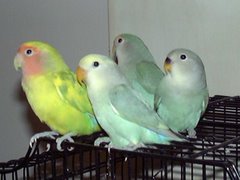General Management of African Lovebirds
African lovebirds are a group of parrots with short squaretails. They all come from Africa. Their main coloring is green with some orange and yellow feathers in the tail. The head coloring varies with the species of which there are quite a few.
African lovebirds thrive on a seed mixture of equal parts millet, canary, with a very little sunflower and hemp. They like green food and apple. They breed in a nest boxes which should be about twice the size of a budgerigar's nest box: 8 by 8 by 8 inches is quite a good size with an entrance hole just big enough for them to get in and out, high up in one side.
Unlike most members of the parrot family, African lovebirds build nests inside their boxes consisting mainly of long thin strips of bark peeled from twiggy branches. They have a unique method of carrying this to the nest box by sticking several strips of bark into the feathers on their rumps and conveying them to the boxes in this manner.
African lovebirds are free breeders in aviaries, the only snag being that, with certain exceptions, they are almost impossible to sex. Various theories have been advanced on how to tell cocks from hens, such as size of head, shape of beak, width between pelvic bones and so on, but whilst these hold good in some cases none of these methods is really reliable.
If you have two lovebirds, which go to nest and never produce eggs you can safely assume that you have two cocks. Conversely, if they produce what appears to be abnormally large clutches of infertile eggs you can be pretty sure that you have two hens.
African lovebirds enjoy a bath so they should regularly be provided with a shallow dish of clean water in which to indulge this habit.
Tame single specimens make good pets although they are unlikely to learn to talk. Pairs usually remain wrapped up in themselves talking little or no interest in their human companions. African lovebirds are usually better kept in out-door aviaries where their bright colors and amusing habits may be enjoyed to greater advantage.
African lovebirds thrive on a seed mixture of equal parts millet, canary, with a very little sunflower and hemp. They like green food and apple. They breed in a nest boxes which should be about twice the size of a budgerigar's nest box: 8 by 8 by 8 inches is quite a good size with an entrance hole just big enough for them to get in and out, high up in one side.
Unlike most members of the parrot family, African lovebirds build nests inside their boxes consisting mainly of long thin strips of bark peeled from twiggy branches. They have a unique method of carrying this to the nest box by sticking several strips of bark into the feathers on their rumps and conveying them to the boxes in this manner.
African lovebirds are free breeders in aviaries, the only snag being that, with certain exceptions, they are almost impossible to sex. Various theories have been advanced on how to tell cocks from hens, such as size of head, shape of beak, width between pelvic bones and so on, but whilst these hold good in some cases none of these methods is really reliable.
If you have two lovebirds, which go to nest and never produce eggs you can safely assume that you have two cocks. Conversely, if they produce what appears to be abnormally large clutches of infertile eggs you can be pretty sure that you have two hens.
African lovebirds enjoy a bath so they should regularly be provided with a shallow dish of clean water in which to indulge this habit.
Tame single specimens make good pets although they are unlikely to learn to talk. Pairs usually remain wrapped up in themselves talking little or no interest in their human companions. African lovebirds are usually better kept in out-door aviaries where their bright colors and amusing habits may be enjoyed to greater advantage.







 Free Ads For Bloggers
Free Ads For Bloggers


No comments:
Post a Comment